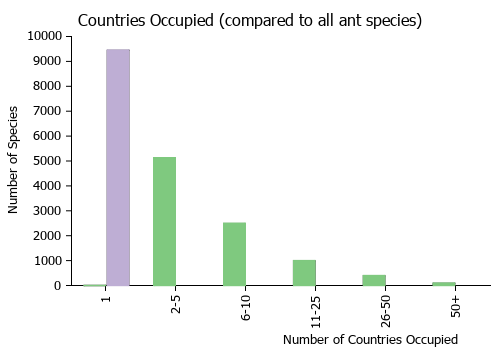Pristomyrmex nitidissimus
| Pristomyrmex nitidissimus | |
|---|---|

| |
| Scientific classification | |
| Kingdom: | Animalia |
| Phylum: | Arthropoda |
| Class: | Insecta |
| Order: | Hymenoptera |
| Family: | Formicidae |
| Subfamily: | Myrmicinae |
| Tribe: | Crematogastrini |
| Genus: | Pristomyrmex |
| Species: | P. nitidissimus |
| Binomial name | |
| Pristomyrmex nitidissimus Donisthorpe, 1949 | |
Nothing is known about the biology of Pristomyrmex nitidissimus.
Identification
Wang (2003) - Worker. Pronotum armed with a pair of teeth; dorsal surfaces of head and alitrunk with numerous scattered foveolate punctures; ventral surface of clypeus with a coarse transverse carina; larger size (HL 1.10-1.16, HW 1.22-1.24, and EL 0.24-0.25).
At first glance, P. nitidissimus appears to resemble Pristomyrmex quadridens, but after being compared in detail, the workers of the two species are separable as follows: P. nitidissimus - Ventral surface of clypeus with a coarse transverse ruga, lacking a toothlike prominence. Larger species, with HW 1.22-1.24, HL 1.10-1.16, EL 0.24-0.25. Basal margin of mandible with a central, broadly curved lobe. Four to five pairs of short hairs present on the dorsums of both petiole node and postpetiole. P. quadridens - Ventral center of clypeus with a toothlike prominence. Smaller species, with HW 0.82-1.02, HL 0.82-1.02, EL 0.14-0.20. Basal margin of mandible almost straight, without a distinctly convex lobe. Usually one to two pairs of hairs present on the dorsums of both petiole node and postpetiole.
A member of the Quadridens species group
Keys including this Species
Distribution
Distribution based on Regional Taxon Lists
Indo-Australian Region: New Guinea (type locality).
Distribution based on AntMaps
Distribution based on AntWeb specimens
Check data from AntWeb
Countries Occupied
| Number of countries occupied by this species based on AntWiki Regional Taxon Lists. In general, fewer countries occupied indicates a narrower range, while more countries indicates a more widespread species. |

|
Estimated Abundance
| Relative abundance based on number of AntMaps records per species (this species within the purple bar). Fewer records (to the left) indicates a less abundant/encountered species while more records (to the right) indicates more abundant/encountered species. |

|
Biology
|
Castes
Queen and Male are unknown.
Images from AntWeb

| |
| Worker. Specimen code castype06993. Photographer April Nobile, uploaded by California Academy of Sciences. | Owned by CAS, San Francisco, CA, USA. |
Nomenclature
The following information is derived from Barry Bolton's Online Catalogue of the Ants of the World.
- nitidissimus. Pristomyrmex nitidissimus Donisthorpe, 1949g: 411 (w.) NEW GUINEA. See also: Wang, M. 2003: 453.
Unless otherwise noted the text for the remainder of this section is reported from the publication that includes the original description.
Description
Worker
Wang (2003) - TL 4.58, 4.69; HL 1.10, 1.16; HW 1.22, 1.24; CI 107, 111; SL 1.14, 1.16; SI 93, 94; EL 0.24, 0.25; PW 0.75, 0.78; AL 1.20, 1.30 (n = 2).
Mandibles with a few longitudinal rugae. Dentition of the masticatory margin of mandible: the strongest apical + the second strongest preapical + a short diastema + a broad basal tooth showing two minute points (which is formed by the fusion of two basal denticles). Basal margin of mandible with a central, broadly curved lobe . Clypeus with a median longitudinal carina. Anterior clypeal margin with a median denticle and two others on each side. Ventral surface of clypeus with a transverse ridge. Frontal carinae extending to the level of the posterior margins of eyes. Antennal scrobe indistinct, but a smooth area present below the frontal carina. Frontal lobes very weak so that the antennal articulations are almost entirely exposed. Antennal scapes, laid on the dorsal head, slightly surpassing the occipital margin of head. Eyes large. Pronotum armed with a pair of teeth. Propodeum with a pair of subtriangular short spines that are slightly longer than the pronotal teeth. Metapleural lobes each with a subtriangular apex. Petiole node with a fairly long anterior peduncle, in dorsal view longer than broad. Postpetiole in profile rounded dorsally, in dorsal view slightly longer than broad. Dorsum of head with numerous rather large, scattered foveolate punctures; space between foveolae usually smooth. Similar foveolate punctures pre sent on the dorsal surface of alitrunk, but promesonotum with a smooth, unsculptured median strip. Petiole, postpetiole, and gaster smooth and shining. Dorsal surfaces of head, alitrunk, petiole node, and postpetiole with numerous erect or suberect hairs. First gastral tergite lacking erect or suberect hairs. A few pairs of forward-projecting hairs present near the anterior clypeal margin. Scapes and tibiae with some erect to suberect short hairs. Color blackish-brown.
Type Material
Holotype worker, New Guinea: Maffin Bay, ix.1944 (E. S. Ross) (California Academy of Sciences) [examined].
References
- Donisthorpe, H. 1949h. A seventh instalment of the Ross Collection of ants from New Guinea. Ann. Mag. Nat. Hist. 12(2): 401-422 (page 411, worker described)
- Wang, M. 2003. A Monographic Revision of the Ant Genus Pristomyrmex (Hymenoptera:Formicidae). Bulletin of the Museum of Comparative Zoology 157(6): 383-542 (page 453, see also)
References based on Global Ant Biodiversity Informatics
- Donisthorpe H. 1949. A seventh instalment of the Ross Collection of ants from New Guinea. Annals and Magazine of Natural History (12)2: 401-422.
- Donisthorpe H. 1950. An eighth instalment of the Ross Collection of ants from New Guinea. Annals and Magazine of Natural History (12)3: 338-341.
- Janda M., G. D. Alpert, M. L. Borowiec, E. P. Economo, P. Klimes, E. Sarnat, and S. O. Shattuck. 2011. Cheklist of ants described and recorded from New Guinea and associated islands. Available on http://www.newguineants.org/. Accessed on 24th Feb. 2011.
- Wang M. 2003. A Monographic Revision of the Ant Genus Pristomyrmex (Hymenoptera:Formicidae). Bulletin of the Museum of Comparative Zoology 157(6): 383-542.
- Wang M. 2003. A monographic revision of the ant genus Pristomyrmex (Hymenoptera:Formicidae). Bulletin of the Museum of Comparative Zoology 157(6):383-542

